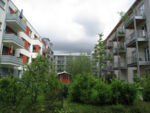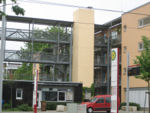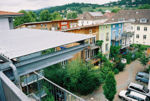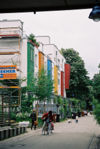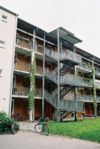Vauban Quarter in Freiburg, Germany
back to Project Biography List
| Name | Vauban district | |
| Place | Freiburg | |
| Country | Germany | |
| Author(s) | Haris Piplas | |
| Completion | 2006 | |
| Client | The city of Freiburg | |
| Project costs | unknown | |

| ||
Rationale: Why is this case interesting?
The case of the Vauban quarter in the city of Freiburg is one of the world´s best practice examples of the creation of whole new urban quarters using various participation techniques in each phase of design and planning. Basically, the initiative for a new quarter was started as an citizen´s initiative. In this case even the city, as the main important body of the local government, gave the coordination of participatory processes to citizen´s NGO. The result is a structure which was shown at many international conferences including UN-HABITAT conferences, EXPO events etc. as a model for ecologically and socially sustainable environment - best practice example for the future of the design and planning disciplines.
Even today, after the completion of the last construction phase, the local citizen´s initiatives play an enormous important role in the community by organizing regular meeting but also events, increasing the community sense - something which Vauban is famous for as well with people buying and not renting estates having a wish to settle down in their community. It is the result of a clear strategy and continuity in participatory processes in Vauban.
Author's personal background
*Haris Piplas* was born in Sarajevo, Bosnia and Herzegovina in 1984, he has studied and graduated at the University in Sarajevo in 2008 where he was awarded as the best student. His main focus was Landscape Architecture, Urban ecology&Urban planning. He receives the German DAAD-scholarship for postgraduate studies in 2008 and is since then attending interdisciplinary Urban Design Master studies at the Technical University in Berlin. His memberships and activities include the membership in the European Federation for Landscape Architecture where he is the editor of the Newsletter and the Young Leaders membership at the Urban Land Institute but also the steering committee membership of the Bosnian Landscape Architecture Association. His actual focus is oriented to planning and sustainable urban development in Bosnia and Herzegovina as a comparison to the EU&USA.
Process Biography Scheme
Who initiated the project and why?
In the South of Freiburg, on the former area of a French barrack site, Vauban, a new district was developed for more than 5,000 inhabitants and 600 jobs. In 1993 the planning for the district started, after three development sections, the completed district (38 hectares) was presented in 2006.
The City of Freiburg has bought the area from the Federal Authorities and paid for this 20,000,000 €. As owner of the Vauban area, the City is responsible for its planning and development.
The district had also the objective to satisfy the growing need for residential units in this German city which was realized by offering space for the named 5000 inhabitants, many of them in private own flats or houses.
The Vauban quarter, due to its position in the southern part of the city and its almost suburban status, had the goal to physically block the additional urban sprawl which was affecting the city of Freiburg, one of Germany´s towns with the highest life quality and land value statistics, causing a non-high but continuous migration to the city.
When was public participation most intensive?
The participation has been very active in every phase of the project as seen from the participation process description and it has been much stronger is much stronger than expected. People really identify with "their" district. This can be seen through:
* the number of 30 Baugruppen/co-housing groups and community building projects,
* the number of people taking part in workshops,
* the number of people committed in local initiatives (district festivals, farmer's market, neighbourhood center,
mother's center, private kindergarden, community gardens, the co-operative district's foodstore, ecumenical initiative for a church in
Vauban and others)
Which participation tools have been applied?
The principle "Learning while Planning" adopted by the bodies of the City of Freiburg allowed flexibility in reacting to new developments. This allowed an extended citizen participation that went far beyond the legal requirements and enabled citizens to participate even in the planning process. The citizen's association "Forum Vauban e.V." applied to coordinate the participation process and was recognized as its legal body by the City of Freiburg in 1995 which enormously raised the participation level. From the very beginning, Forum Vauban did not want to restrict itself to merely organizing but also developed own suggestions for the planning and building of the district. Therefore the project was created and implemented together with the City of Freiburg and several other partners. That is a reason why Freiburg-Vauban was presented as "German Best Practice" at the UN Habitat II Conference 1996 in Istanbul because of the cooperative planning process. In the phase after the planning and construction the participation is still very high but moved to a different dimension and promoted through the "Stadtteilverein Vauban e.V.".
The huge number of citizens allowed a variety of tools which have been used in the public participation process. They range from open houses, festivities, establishing of information platforms (journals, websites etc.) as indirect ones which influence the process but do not have a jurisdictional character. The direct methods include workshops with planners and the city administration as a part of German planning laws where the citizen´s voice goes through official procedures. The tool will be explained further in the next section where we will speak also about levels of participation.
On which level of participation?
If take the manual "Awakening Participation: Building Capacity For Public Participation In Environmental Decisionmaking For CEE" (published by The Regional Environmental Center; Szentendre, December 1996) and its pyramidal overview of participation levels as shown above, it can be concluded that the levels of participation which are visible from the graphic can be manifested in the Vauban quarter and its three phases as divided by the author. In the first phase before the construction the levels "information" and "Citizens feedback" were realized, especially during the "Wohnfrühling" action in 1996 but also "Consultations" and "Joint planning" phase after the publishing of the Master plan.
In the second phase during all the three construction stages the participation was mainly focused on active participation as a part of the numerous workshops on different objects (e.g. Citizen´s house workshop) and festivals .
In the third phase after the construction process (2006- ) the citizens participation is still very high but mainly focused on providing informations and feedback on happenings in the quarter including the maintenance process due to a high level of private-own properties.
Which stakeholders have been involved?
THE CITY OF FREIBURG
The entire development of the new city district Vauban is taken over by the City of Freiburg. As soon as it became clear that the french Army would leave the Vauban barrack site, the Freiburg City Council decided to commence with the urban development process immediately. This started with the whole planning process including competitions for the urban design concepts as well als the implementation. The City bought the whole area from the Federal Authorities (20,000,000 €). During the planning process the City opened an extended citizen participation process and supported this process also financially. The City formed its own project team within the Building Department. This team controls the entire project and coordinates the development of the site as well as developing the infrastructure such as the school and kindergardens. One central task is the sale of the building lots.
The marketing of the building sites addresses mainly private builders and "Baugruppen" (groups of building owners). Some building companies or commercial developers were also accepted in order to guarantee diversity. This brings a great variety to the potential buyers and allowes an interesting implementation process. One experiences, a pleasant variety in the small scale and the viviality in the first phase of the project - a desired result which couples positive urban design with a high level of quality in life.
The marketing process demanded a high input of the City's staff especially to particular individuals involved.
From the beginning, the City aimed at strengthening social and ecological aspects within Vauban and made them part of the development plan. Through the participation process these demands were refined, developed and made complete.
FORUM VAUBAN
The organisation Forum Vauban e.V. was founded in 1994 to support the planning and building process of the new city district Freiburg-Vauban which is designed for 5.000 inhabitants. The main fields of activity are:
* Organizing a far-reaching citizen participation.
* Supporting the implementation of community-based building projects such as "Baugruppen" (groups of building owners),
co-housing and co-operative building.
* Realisation of a sustainable model district, especially in the fields of traffic and energy.
* Coordination of the social work and implementation of a neighbourhood center
The Forum was initiated by a group of active citizens and recognized as a legal body for the citizen participation by the City of Freiburg in 1995. A small team of full-time professionals as well as an honorary executive board and several working groups contribute to the thematic and organisational work of the association. Forum Vauban is being financed through membership fees, donations, public grants and moderate economic income.
GENOVA EG, was founded in 1997. The co-operative has built 36 housing units (10 of which are publicly co-financed flats) in the first development section and another 40 units in the second section.
Genova originated from Forum Vauban. Genova sees itself in the tradition of the classic co-operative goals of responsibility and self-organisation, collective building and living as well as the creation of communal property. Genova emphasis the issue of young and old living together. Furthermore, an ecological and inexpensive building concept was adopted by the members collectively. People of different ages and life-styles as well as socially and financially disadvantaged people are all integrated into the project. The residents actively participate in the planning process - both where the architecture (orientation and design of the buildings, facades, colors, etc.) and the basic plans for the individual apartments are concerned. The participation takes the form of residents' meetings, workshops, a co-operative council, and also residents' representatives on the management team. The financial risks involved in the project are shared by all members from the very beginning.
The first two four-storey apartment buildings with 36 housing units (from 44 m2 to 157 m2 ) were finished in August 1999. Additional to this, a 50-m2-large communal house, a rentable guestroom and a communal laundry were built. The access galleries, a bridge connecting both houses, the gardens and also the nearby lane developed into attractive semi-public spaces creating a special neighbourhood atmosphere.
THE BUERGERBAU AG (Citizens' Building Stock Corporation) has specialized to coordinate community building projects. The corporation offers all kinds of services, starting with the development of the project and continuing with the planning and building process. It's the job of the company to care about almost everything until the builders move into their new homes. Buergerbau AG also originated from Forum Vauban.
Have there been any festivities in order to involve the public?
Forum Vauban as legal body of the participation process organized many workshops and excursions, three district's festivals and the international conference "UrbanVisions" as a pre-event of the UN "Urban 21" conference in Berlin. About 10 events were co-organized with the City of Freiburg. The workshops were mainly adressing future housing owners, architects, craftsmen, the building industry and financial institutes. For example, the workshops were focusing on
* ecological building, energy saving technologies and solar energy,
* greening roofs and the use of rainwater,
* greening fassades and the ecological design of green spaces,
* basic information for future building owners, espcecially Baugruppen/co-housing groups (concepts, legal and financial aspects),
exchanging information between Baugruppen of the first and the second development section of Vauban and creating new Baugruppen
* building with local wood,
* financing of building projects,
* design of district's public areas (streets, public green spaces),
* design of the neighbourhood center (using the concept "planning for real"),
* and many other aspects.
Additional, numerous regular working groups' gatherings and meetings of special projects or Baugruppen / co-housing groups linked with or situated at Vauban took place regulary. Currently, there are about four meetings of district groups each week in the rooms of Forum Vauban. The working groups' issues are: traffic / mobility, energy, coordination of Baugruppen, social life (roundtable and advisory board of social initiatives, representatives from the City of Freiburg and some welfare institutions), business (roundtable with Baugruppen, commercial representatives and the City of Freiburg), and others.
Continuous press reports (regional, nationwide, international) about Vauban reveal the public interest. The main media for local information/communication are the Forum's bi-monthly district magazine "Vauban actuel" and the official website.
Last but not least, the regular meetings of the "Gemeinderätliche Arbeitsgruppe Vauban", the City Council's Vauban committee and the meetings of the City Council itself have major influence on the public dialogue.
To summarize the whole participation dialogue and the output:
* Participation: The principle "Learning while Planning" and the extended citizen participation with Forum Vauban as ist agency set new standards
of communication, interaction and integration (see "project structure" and "public dialogue").
* Social interaction: The social work being part of the developing process helps to set up stable community and neighbourhood structures. Very
often, such structures already grew through the building process. Many Baugruppen (groups of building owners) and the Genova co-operative have
developed a sensitively balanced community life. These structures are the fertile ground for further initiatives within the district (e.g. the
co-operative food store, the farmer's market initiative, the mother's center, and many others).
* Semi-public and public spaces: Neighbourhood and community structures become visible by the spaces which are created through them. The
semi-public spaces (such as access-galleries, community gardens and rooms) were created mainly by the Genova- and Baugruppen-projects. The design
of the public green spaces, the resident's streets and the neighbourhood center are developed during several meetings and workshops together with
the residents.
Who made the major decisions and when?
The decisions made by the authorities in accordance with the other stakeholders as it was described above.
Image Gallery
References
Awakening Participation: Building Capacity For Public Participation In Environmental Decisionmaking For CEE; The Regional Environmental Center; Szentendre, December 1996
Tools to Support Participatory Urban Decision Making; Urban Governance Toolkit Series; United Nations Centre for Human Settlements (Habitat), Nairobi, July 2001
http://www.forum-vauban.de/overview.shtml
http://www.flickr.com (only Creative Commons-Licensed photos)
http://www.vauban.de/info/abstract.html
http://www.livablestreets.com/.../vauban-freiburg-germany
http://www.secureproject.org/download/18.../Vauban_Germany.pdf
http://www.quartiersarbeit-vauban.de
http://www.news.sky.com/skynews/Home/Sky-News-Archive/.../20080641301897
http://www.freiburg.de/servlet/PB/menu/.../index.html
back to Project Biography List



